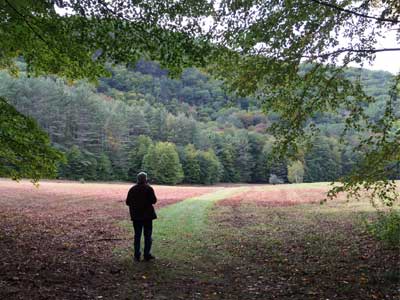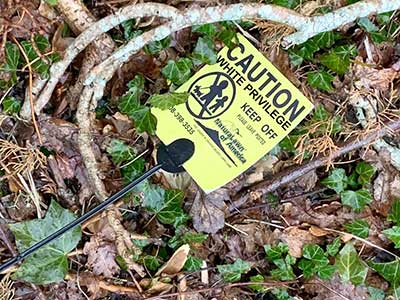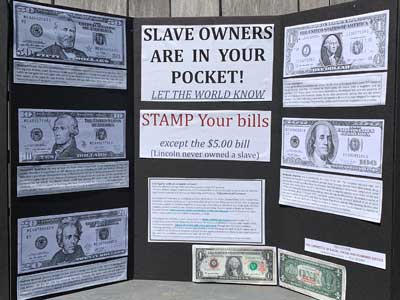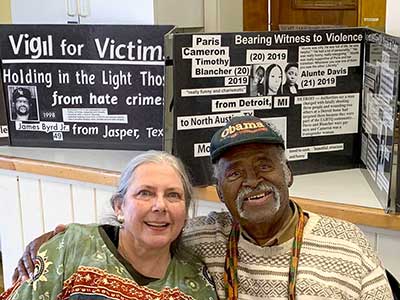by Amina Al-Sadi & Jeannie Yandel | December 2016
For about $300, a 9-year-old girl named Ashley was sold as a slave.
Her mother, Rose, remained a house slave at a mansion in South Carolina. This was the 1850s, roughly a decade before Abraham Lincoln’s Emancipation Proclamation, setting slaves free. Before mother and daughter were separated, Rose gave Ashley a cotton sack. It contained a tattered dress, three handfuls of pecans and a lock of her hair. Rose told Ashley it was filled with love — always. Ashley never saw her mom again, but she kept the sack. It was handed down through the generations, along with her story, to her granddaughter, Ruth Middleton. Ruth, a single mom in Philadelphia, stitched her family story into the cloth sack in 1921…. Nearly 100 years later, the bag was found at a flea market in Tennessee. A woman bought it and donated it to Middleton Place, a famous plantation in South Carolina that refuses to shy away from its awful history.
TAGS: [Racial Terrorism] [2010’s] [Slavery] [History] [Art & Culture] [Civil War]
Resource Links Tagged with "2010’s"
Hiring Discrimination Against Black Americans Hasn’t Declined in 25 Years
by Lincoln Quillian, Devah Pager,Arnfinn H. Midtbøen, Ole Hexel | October 2017
Many white Americans believe that race is no longer central to one’s opportunities in life, and that we’re well on our way to systemic racial equality. Are these beliefs accurate? While it’s often difficult to measure levels of discrimination over time, research into hiring discrimination shows that black Americans still face discrimination in the hiring process. A meta-analysis of callback rates from all existing field experiments (24 total, including data from more than 54,000 applications across more than 25,000 positions) showed evidence of discrimination against both black and Latino applicants. Since 1990 white applicants received, on average, 36% more callbacks than black applicants and 24% more callbacks than Latino applicants with otherwise identical résumés. When it comes to Latinos, there is some evidence of a decline in discrimination over the past 25 years. Due to the small number of field experiments including Latinos, statistical tests indicate the evidence of decline is inconclusive. For blacks, however, researchers found no change in hiring rates over time.
TAGS: [Collective Action] [2010’s] [Systemic Racism] [Employment] [Denial] [Black Lives Matter] [Latino/a] [White Blindness] [White Privilege] [White Supremacy] [Implicit Bias] [Implicit Racism]
Police Abuse Complaints by Black Chicagoans Dismissed Nearly 99 Percent of the Time; Investigators Rarely Sustain Allegations of Any Kind
by Shane Shifflett, Alissa Scheller, Scilla Alecci and Nicky Forster | December 2015
Long before Chicago police Officer Jason Van Dyke shot and killed a black teenager, sparking a public outcry and now a Justice Department probe into the city’s troubled police department, he had established a track record as one of Chicago’s most complained-about cops. Since 2001, civilians have lodged 20 complaints against Van Dyke. None were sustained by investigators. While it may seem surprising that so many complaints against one officer would be tossed out, a Huffington Post analysis of four years of city data released by the Invisible Institute, a nonprofit journalism organization, reveals that there are more than 180 city police officers with more complaints than Van Dyke who weren’t disciplined at all over that time. Most of those complaints were made by black residents, whose allegations of police misconduct are dismissed at nearly four times the rate of complaints filed by whites, HuffPost found.
TAGS: [Racial Terrorism] [2010’s] [Police Shootings] [Policing] [Black Lives Matter] [Justice System] [Silencing POC] [Denial] [Accountability] [Systemic Racism] [-ing While Black]
History of Institutional Racism in U.S. Public Schools
by Matthew Lynch | October 2019
Racial biases are not unknown to the history of the U.S. education system. Dating back to the 1800s, Native American children were taken from their homes and forced into boarding schools where they were pushed to abandon their native language and adopt a foreign religion. Education was used to assimilate these Native American children to White culture forcibly. This institutional racism created a belief that White culture was far better than the Native American Way. These racial biases expressed themselves with the Chinese in a different manner. Instead of forcing them to assimilate into the prescribed White educational system, Chinese-American children were barred completely from going to school. Later legislation stated they had a right to public education but segregated them into Chinese-only schools. Latinos faced the same fate as the Chinese in being methodically shut out from education. Latinos were later granted access to education under the ruling of a judge with a particular belief; the judge asserted that Latinos were of White descent and therefore above other minorities. In the American South, laws against African-Americans completely obstructed their ability to get an education. By law, it was illegal for an African-American to learn how to read and write. African-American communities had to turn to schools established by Quakers and Christians in order to get an education. But turmoil and violence would always find their white allies, forcing these schools to close their doors. Fear of uprising was palpable in these plantation states, and illiteracy became a weapon used against African-Americans. If African-Americans remained uneducated, plantation owners and Southern Whites believed, they would not revolt, maintaining the status quo of slavery.
TAGS: [Collective Action] [2010’s] [History] [Implicit Bias] [Indigenous] [White Culture] [Asian] [Black Lives Matter] [Quaker] [Faith-Based/Spiritual] [Slavery] [Social Justice] [White Privilege] [Teachers]
What it Means to be Black in the American Educational System
by The Conversation | October 2016
Sadly, racism and discrimination are facts of life for many black Americans. As an African-American scholar who studies the experiences of black college students, I am especially interested in this issue. My research has found that black college students report higher levels of stress related to racial discrimination than other racial or ethnic groups. The unfortunate reality is that black Americans experience subtle and overt discrimination from preschool all the way to college.
…The results of a recent survey by the Pew Research Center underscore this point. The survey found that black Americans with some college experience are more likely to say that they have experienced discrimination compared to blacks who did not report having any college experience.
TAGS: [Strategies] [2010’s] [White Privilege] [Systemic Racism] [Microaggressions] [Police Shootings] [Policing] [History] [Black Lives Matter] [-ing While Black] [Teachers]
For Our White Friends Desiring to be Allies
by Courtney Ariel | August 2017
1. Listen more; talk less. …
2. For one out of every three opinions/insights shared by a person of color in your life, try to resist the need to respond with a better or different insight about something that you read or listened to as it relates to their shared opinion. …
3. Being an ally is different than simply wanting not to be racist (thank you for that, by the way). Being an ally requires you to educate yourself about systemic racism in this country. …
4. Please try not to, “I can’t believe that something like this would happen in this day and age!” your way into being an ally when atrocities like the events in Charleston, S.C. …
5. Ask when you don’t know — but do the work first. This is nuanced. …
6. And finally, stop talking about colorblindness.
TAGS: [Individual Change] [2010’s] [Tips-Dos/Don’ts] [Anti-Racism] [Silencing POC] [White Supremacy] [White Privilege] [Systemic Racism] [Colorblindness] [Indigenous] [Slavery] [Black Lives Matter] [Intersectionality] [Denial] [Reparations]
8 Ways People of Color are Tokenized in Nonprofits
by Helen Kim Ho | September 2017
There’s a type of racism in the workplace many of us have personally witnessed, perpetrated or experienced: tokenism. Nowhere have I seen this play out more than in the nonprofit space. Tokenism is, simply, covert racism. Racism requires those in power to maintain their privilege by exercising social, economic and/or political muscle against people of color (POC). Tokenism achieves the same while giving those in power the appearance of being non-racist and even champions of diversity
TAGS: [Strategies] [2010’s] [White Privilege] [White Culture] [Systemic Racism] [Economics] [History] [Tips-Dos/Don’ts] [Social Justice] [Accountability] [White Supremacy] [White Blindness] [Black Lives Matter] [Asian] [Politics] [White Fragility/Tears] [Employment]
Dealing with White Guilt Is Not Our Role for Your Soul; Black People Aren’t Your Priests and Priestesses
by Sam McKenzie Jr | November 2018
After facilitating a hearty discussion for a newly formed anti-racism group, Jaleesa, the group facilitator, notices an elderly white man hanging back and waiting for her. When they are face to face, the man tells her that he used to be a racist. He mentions how he made racist jokes and used racial slurs because “that was the time.” He says he has changed, and he wanted to share, but his guilt was obvious.
TAGS: [Individual Change] [2010’s] [Anti-Racism] [White Defensiveness] [White Blindness] [White Privilege] [Denial] [Black Lives Matter]
You’re Already on Stolen Land. You Might as Well Pay Rent.
by Sena Crow | November 2019
And yes, if you’re wondering: this post is for white settlers. f you’re not already actively working to unlearn colonizing habits and unconditionally support Indigenous people, now is the perfect time to start. It’s November, and that means it’s Native History Month. Native History Month urges us to ask how we can better recognize, support, and protect Indigenous communities.First, ask yourself this question every day: Whose land am I living on? The second question to ask yourself: What do I own on this land? And the third: What people have lost from what I have gained?
TAGS: [Individual Change] [2010’s] [Indigenous] [Systemic Racism] [White Supremacy] [White Culture] [White Privilege] [History] [Social Justice] [Accountability]
If You Truly Knew What the N-Word Meant to Our Ancestors, You’d NEVER Use It; It Was Used and Still Can Be Used to Make Us Hate Ourselves
by Brando Simeo Starkey | May 2017
A few years ago, I read slave narratives to explore the lives of black agricultural workers after the end of the Civil War. The narratives came from the Federal Writers Project of the Works Progress Administration, a program that employed researchers from 1936 to 1938 to interview former enslaved people, producing more than 2,300 narratives that, thankfully, reside online and are fully searchable.
TAGS: [Collective Action] [2010’s] [Slavery] [Civil War] [White Supremacy] [White Culture] [White Privilege] [Systemic Racism] [Definitions]
The Decline of Black Business; and What it Means for American Democracy
by Brian S. Feldman | May 2017
The last thirty years also have brought the wholesale collapse of black-owned independent businesses and financial institutions that once anchored black communities across the country. In 1985, sixty black-owned banks were providing financial services to their communities; today, just twenty-three remain. In eleven states that headquartered black-owned banks in 1994, not a single one is still in business. Of the fifty black-owned insurance companies that operated during the 1980s, today just two remain. Over the same period, tens of thousands of black-owned retail establishments and local service companies also have disappeared, having gone out of business or been acquired by larger companies. Reflecting these developments, working-age black Americans have become far less likely to be their own boss than in the 1990s.
TAGS: [Strategies] [2010’s] [Art & Culture] [Justice System] [History] [Economics] [Systemic Racism] [Black Lives Matter] [Social Justice] [Politics] [Slavery] [Civil War] [White Supremacy] [White Privilege] [Racial Covenants] [Racial Terrorism]
The Treaty That Forced the Cherokee People from Their Homelands Goes on View
by SMITHSONIAN VOICES | April 2019
On Friday, April 12, 2019, representatives of the three federally recognized tribes of the Cherokee people—the Cherokee Nation of Oklahoma, Eastern Band of Cherokee Indians, and United Keetoowah Band of Cherokee Indians in Oklahoma—came together at the National Museum of the American Indian in Washington, D.C., for the installation of the Treaty of New Echota in the exhibition Nation to Nation: Treaties Between the United States and American Indian Nations. Negotiated in 1835 by a minority party of Cherokees, challenged by the majority of the Cherokee people and their elected government, the Treaty of New Echota was used by the United States to justify the forced removal of the Cherokees from their homelands along what became known as the Trail of Tears.
TAGS: [Strategies] [2010’s] [Indigenous] [History] [Art & Culture] [White Supremacy] [White Culture] [Systemic Racism] [Politics] [Justice System]
Retracing Slavery’s Trail of Tears; America’s Forgotten Migration – the Journeys of a Million African-Americans from the Tobacco South to the Cotton South
by Edward Ball | November 2015
“My grandfather went to the folks who had owned our family and asked, ‘Do you have any documentation about our history during the slave days? We would like to see it, if possible.’ The man at the door, who I have to assume was from the slaveholding side, said, ‘Sure, we’ll give it to you.’ When Delores McQuinn was growing up, her father told her a story about a search for the family’s roots. He said his own father knew the name of the people who had enslaved their family in Virginia, knew where they lived—in the same house and on the same land—in Hanover County, among the rumpled hills north of Richmond.“The man went into his house and came back out with some papers in his hands. Now, whether the papers were trivial or actual plantation records, who knows? But he stood in the door, in front of my grandfather, and lit a match to the papers. ‘You want your history?’ he said. ‘Here it is.’ Watching the things burn. ‘Take the ashes and get off my land.’ “The intent was to keep that history buried,” McQuinn says today. “And I think something like that has happened over and again, symbolically.”
TAGS: [Racial Terrorism] [2010’s] [History] [Slavery] [Silencing POC] [Confederate Monuments] [Politics] [Black Lives Matter] [Definitions] [White Supremacy] [White Culture] [White Privilege] [Social Justice] [Civil War] [Accountability]
This Emmett Till Memorial Was Vandalized Again. And Again. And Again. Now, It’s Bulletproof.
by Kayla Epstein | October 2019
The cars came one by one, down a gravel road and through a cotton field, to the edge of the Tallahatchie River and the spot where, 64 years ago, historians believe Emmett Till’s lifeless body was pulled from the river. The vehicles carried Till’s relatives, including cousin the Rev. Wheeler Parker, community leaders and advocates dedicated to keeping his memory alive. The group had gathered on Saturday at noon in the remote spot near Glendora, Miss., to dedicate yet another memorial to Till. And this time, it was bulletproof. It took 50 years to get the first memorial to Till erected in Tallahatchie County, the site of the lynching that helped spark the civil rights movement. But then an entirely new battle began: keeping the tribute intact.
TAGS: [Racial Terrorism] [2010’s] [History] [Systemic Racism] [White Supremacy] [White Culture] [Social Justice] [Black Lives Matter] [White Privilege] [White Defensiveness]
How the GI Bill’s Promise Was Denied to a Million Black WWII Veterans; The Sweeping Bill Promised Prosperity to Veterans. So Why Didn’t Black Americans Benefit?
by Erin Blakemore | September 2019
When Eugene Burnett saw the neat tract houses of Levittown, New York, he knew he wanted to buy one. It was 1949, and he was ready to settle down in a larger home with his family. The newly established Long Island suburb seemed like the perfect place to begin their postwar life—one that, he hoped, would be improved with the help of the GI Bill, a piece of sweeping legislation aimed at helping World War II veterans like Burnett prosper after the war. But when he spoke with a salesman about buying the house using a GI Bill-guaranteed mortgage, the door to suburban life in Levittown slammed firmly in his face. The suburb wasn’t open to Black residents.
TAGS: [Strategies] [2010’s] [Systemic Racism] [Racial Covenants] [Black Lives Matter] [Economics] [White Privilege] [White Culture] [White Supremacy] [Denial] [Housing] [Politics] [History] [Social Justice]
How U.S. Backed Banks Robbed Ex-Slaves of $66 Million
by Jared Brown | Month Unknown 2016
In 1871, Congress authorized banks to provide business loans and mortgages. Paradoxically, such mortgages and loans were usually administered to whites at the expense of black depositors. Risky investments and lending patterns, coupled with cronyism and corruption at the level of upper management, slowly undermined the stability of the bank. According to Black Past, “By 1874, massive fraud among upper management and among the board of director had taken its toll on the bank. Moreover, economic instability brought upon by the Panic of 1873, coupled with the bank’s rapid expansion, proved disastrous.” The Freedmen’s Bank was officially closed on June 29, 1874. At the point of closing, 61,144 black depositors were robbed of the modern equivalent of $66 million. The failure of the bank left many black depositors and borrowers distrustful of the white banking community, especially since the Freedmen’s Bank was established and managed by white men.
TAGS: [Strategies] [2010’s] [Systemic Racism] [History] [White Supremacy] [White Culture] [White Privilege] [Slavery] [Accountability] [Social Justice] [Economics] [Denial] [Racial Covenants] [Black Lives Matter]
Breaking From White Solidarity
by Erin Monahan | August 2019
Several times in the last week alone I have had encounters with white women who identify as liberal who have gotten upset when I address someone in the group about the casually racist or sexist thing they said. In one instance, I gave a very gentle mention to the person who said the casually racist statement. Because we are adults and we should be able to speak plainly about these things, we moved on. Everything seemed fine. As the night went on, a casually sexist thing was said, and then another casually racist thing was said. I interrupted both times with the intention to engage in conversation about it. … I have been addressed about my racism too many times to count. There are times that I have been defensive and violent in my response to being called out. And though I feel deep regret and shame for that behavior, I am always reflecting on these situations and thinking about how I can receive information with less guilt, shame, and anger the next time. I ask myself, what do I need to heal in myself in order to respond with more reception, true humility, and less ego? It’s never comfortable to receive how I have been racist. I feel a surge of embarrassment and desperation. I want to find a way to deny it, a way to rationalize my way out of it, a way to make myself feel better. This is my whiteness centering me. I focus on my feelings instead of my impact.
TAGS: [Individual Change] [2010’s] [White Fragility/Tears] [White Culture] [Cognitive Dissonance] [White Supremacy] [White Privilege] [Social Justice] [White Defensiveness] [White Blindness] [Anti-Racism]
Tignon Laws: The Dreadful Rule That Banned Black Women from Displaying Their Hair
by Farida Dawkins | February 2018
… there was a time when black women weren’t allowed to display their hair in public. Keep reading to learn about the Tignon Laws and how it was used to fuel racial tensions in the United States. A tignon (tiyon) is a headdress used to conceal hair. It was adorned by free and slave Creole women of African ancestry in Louisiana in 1786. The sumptuary law was enacted under Governor Esteban Rodriguez Miró. The regulation was meant as a means to regulate the style of dress and appearance for people of color. Black women’s features often attracted male white, French, and Spanish suitors and their beauty was a perceived threat to white women. The tignon law was a tactic used to combat the men pursuing and engaging in affairs with Creole women. Simply put, black women competed too openly with white women by dressing elegantly and possessing note-worth beauty.
TAGS: [Strategies] [2010’s] [Systemic Racism] [Silencing POC] [Black Lives Matter] [Definitions] [Denial] [White Supremacy] [White Privilege] [Slavery] [History]
White Suffragettes Chose White Supremacy over Collective Liberation
by Reina Sultan | January 2020
White women love saying some variation of, “We are the granddaughters of the witches you could not burn”—even though no “witches” were actually burned at the stake during the Salem Witch Trials. It would be more accurate for them to say, “We are the granddaughters of the Suffragettes who sold out Black and brown women for their own political gain.” Because white women have been choosing whiteness since they fought for the right to vote.
TAGS: [Assumptions] [2010’s] [Systemic Racism] [History] [White Supremacy] [White Culture] [White Privilege] [White Blindness] [Politics] [Indigenous] [Myths] [Silencing POC] [White Fragility/Tears] [Collective Action]
This African American Woman Got No Credit for Designing the Image of Roosevelt on the U.S Dime in 1944
by Elizabeth Ofosuah Johnson | August 2018
Selma Burke was born on December 31, 1900, and was the 7th of ten children to her parents. Her father worked in the railway service and was a church minister, while her mother was a stay at home mom. At a very young age, Selma showed artistic skill and would often draw or carve objects out of used paper and cardboard. … In 1943, Selma entered a national competition which she won. Sponsored by the Fine Arts Commission in Washington D.C, the competition was to create a profile portrait of the then U.S. President Franklin Delano Roosevelt with a granted commission. Selma then wrote a letter to the president and was invited to the White House to do her sketch.
TAGS: [Assumptions] [2010’s] [Systemic Racism] [History] [Art & Culture] [Silencing POC] [Myths] [Black Lives Matter] [Denial] [White Culture] [White Privilege] [White Supremacy]
Black Cop Who Shot a White Woman Sentenced to 12 1/2 Years in Prison
by blacknews.com | June 2019
The sentencing came two days after Noor’s lawyers asked the judge for no jail time or even just “less time than what sentencing guidelines call for.” They claimed that Noor showed a rather good attitude and sense of remorse during trial. Noor, who is a 33-year old Somali-American, was responding to a 911 call of a possible assault near the caller’s house. Noor was with his partner, Matthew Harrity, when they arrived on the scene and he saw a woman in a pink shirt with blond hair outside of Harrity’s window. Noor said that when the woman raised her right arm, he was threatened and his initial reaction was to fire one shot. “My intent was to stop the threat and save my partner’s life,” he said. Afterwards, he said he immediately realized that he had shot an innocent woman. The woman named Justine Damond is an Australian and she was the one who called 911 at that time. He remorsefully said on the stand, “I felt like my whole world came crashing down. I couldn’t breathe.”
TAGS: [Strategies] [2010’s] [Justice System] [Systemic Racism] [Policing] [Police Shootings] [White Privilege] [White Culture]
American Churches are Apologizing for a Centuries-Old Injustice That Still Reverberates Today; How We Can Start to Undo the Damage
by Melissa J. Gismondi | September 2018
In 2016, the General Assembly of the Presbyterian Church (PCUSA) repudiated the historic “doctrine of discovery.” Although it might sound benign, the doctrine was the pernicious theory that Christians could claim and conquer land inhabited by non-Christians. It helped justify and promote the violent colonization of indigenous lands throughout the Americas. This summer, the Assembly followed up on that repudiation by issuing a report outlining specific actions the church can take to grapple with the doctrine’s legacy. They include official acknowledgments before meetings of the indigenous nations on whose land the meeting is taking place, as well as more discussion of indigenous theologies and educational resources on the doctrine.
TAGS: [Collective Action] [2010’s] [Indigenous] [Faith-Based/Spiritual] [History] [Systemic Racism] [Justice System] [Denial] [White Culture] [White Supremacy] [White Blindness] [Accountability] [Economics] [White Privilege] [Role Model] [Strategies] [Tips-Dos/Don’ts]
How the History of Blackface Is Rooted in Racism
by Alexis Clark | February 2019
Blackface began in the US after the Civil War as white performers played characters that demeaned and dehumanized African Americans. The portrayal of blackface–when people darken their skin with shoe polish, greasepaint or burnt cork and paint on enlarged lips and other exaggerated features, is steeped in centuries of racism. It peaked in popularity during an era in the United States when demands for civil rights by recently emancipated slaves triggered racial hostility. And today, because of blackface’s historic use to denigrate people of African descent, its continued use is still considered racist. “It’s an assertion of power and control,” says David Leonard , a professor of comparative ethnic studies and American studies at Washington State University. “It allows a society to routinely and historically imagine African Americans as not fully human. It serves to rationalize violence and Jim Crow segregation.”
TAGS: [Collective Action] [2010’s] [History] [Systemic Racism] [Civil War] [White Supremacy] [White Culture] [White Privilege] [Art & Culture] [Assumptions] [Myths] [White Blindness] [Social Justice] [Economics]
Teaching America’s Truth
*Paywall Alert
by Joe Heim | August 2019
For generations, children have been spared the whole, terrible reality about slavery’s place in U.S. history, but some schools are beginning to strip away the deception and evasions. “Think about this. For 246 years, slavery was legal in America. It wasn’t made illegal until 154 years ago,” the 26-year-old teacher told the 23 students sitting before him at Fort Dodge Middle School. “So, what does that mean? It means slavery has been a part of America much longer than it hasn’t been a part of America.” It is a simple observation, but it is also a revelatory way to think about slavery in America and its inextricable role in the country’s founding, evolution and present.
TAGS: [Assumptions] [2010’s] [Slavery] [History] [Collective Action] [Myths] [White Culture]
The 1950s: Long Live the Lumbee
by Philip Gerard| July 2019
The Native Americans of Robeson County are strong and proud, but their history is marked by the struggle to overcome bias. In the 1950s, a watershed moment brings national attention to the Lumbee Tribe.
Through the early decades of the 20th century, the Lumbee Indians were not much known outside of Robeson County in the southeastern part of the state — though their forebears settled there by at least 1754, when an agent for colonial Gov. Arthur Dobbs discovered some 50 families living at the headwaters of the Little Pee Dee. His description was less than flattering: “a lawless People [who] possess the Lands without patent or paying quit rents.” Thus began a long history with white settlers during which the Lumbee struggled to gain respect.
TAGS: [Assumptions] [2010’s] [Indigenous] [History] [Implicit Bias] [Myths] [Politics] [Systemic Racism] [Denial] [White Supremacy] [Health Disparities] [Racial Terrorism] [Justice System]
Why Talk about Whiteness? We can’t Talk about Racism without it.
by Emily Chiariello | Summer Issue 2016
This fundamental disconnect between the racial self-perceptions of many white people and the realities of racism was part of what motivated documentary filmmaker, director and producer Whitney Dow to create The Whiteness Project. “Until you can recognize that you are living a racialized life and you’re having racialized experiences every moment of every day, you can’t actually engage people of other races around the idea of justice,” Dow explains. “Until you get to the thing that’s primary, you can’t really attack racism.” Dow’s work, among other activism and scholarship focused on whiteness, has the potential to stimulate meaningful conversations about whiteness and move white folks past emotions like defensiveness, denial, guilt and shame (emotions that do nothing to improve conditions for people of color) and toward a place of self-empowerment and social responsibility.
TAGS: [Collective Action] [2010’s] [Teachers] [Systemic Racism] [White Privilege] [White Supremacy] [White Culture] [White Fragility/Tears] [Anti-Racism] [Social Justice] [Advocacy] [Tips-Dos/Don’ts] [Assumptions]
This Waltz Once Attributed to Strauss Is Actually by Indigenous Mexican Composer Juventino Rosas
by Stephen Raskauskas | May 2017
The waltz is typically associated with composers from German-speaking countries. The word waltz is, after all, German. Viennese composers like Beethoven and Schubert composed waltzes. Viennese composer Johann Strauss II was known as the “Waltz King.” But at the same time that the Viennese were waltzing around ballrooms and clinking their champagne glasses, the people of Mexico were enjoying waltzes, too, many of which were composed in Mexico. One of the most famous waltz composers in Mexico was Juventino Rosas. He was born in 1868 in Santa Cruz de Galeana to parents who were Otomí. The Otomí people are one of many indigenous groups in Mexico. In 2015, over 25,000,000 people living in Mexico identified as indigenous.
TAGS: [Assumptions] [Indigenous] [2010’s] [Latino/a] [Myths] [Art & Culture] [Implicit Racism] [History] [Silencing POC]
Martin Luther King Jr Was a Radical. We Must Not Sterilize His Legacy
by Cornel West | April 2018
In this brief celebratory moment of King’s life and death we should be highly suspicious of those who sing his praises yet refuse to pay the cost of embodying King’s strong indictment of the US empire, capitalism and racism in their own lives. We now expect the depressing spectacle every January of King’s “fans” giving us the sanitized versions of his life. We now come to the 50th anniversary of his assassination, and we once again are met with sterilized versions of his legacy. A radical man deeply hated and held in contempt is recast as if he was a universally loved moderate.
TAGS: [Collective Action] [2010’s] [Economics] [Systemic Racism] [History] [White Blindness] [White Supremacy] [White Culture] [Social Justice] [Policing] [Politics] [Denial]
From Most Hated to American Hero: The Whitewashing of Martin Luther King Jr.
by Michael Harriot | April 2018
This week, America will commemorate the 50th anniversary of the assassination of the Rev. Martin Luther King Jr., the most famous and beloved civil rights leader in the nation’s history. Lost in the remembrance of the death of our nation’s most heralded warrior for social justice is the fact that—at the time of his death—King was a man in exile. Contrary to popular belief, when King died, he was not an icon of freedom and equality. In fact, most of the country disliked him. Sadly, on April 4, 1968, a bullet splattered bits of Martin Luther King Jr.’s brains and blood across the balcony of Memphis, Tenn.’s Lorraine Motel. Then, and only then, was white America ready to make him a hero.
TAGS: [Strategies] [2010’s] [Myths] [History] [White Culture] [White Defensiveness] [Collective Action] [Role Model] [Social Justice] [Assumptions] [White Blindness] [Silencing POC] [Systemic Racism]
Confronting Racism Is Not About the Needs and Feelings of White People Too Often Whites at Discussions on Race Decide for Themselves What Will be Discussed, What They Will Hear, What They Will learn. And it is Their Space. All Spaces Are.
*Paywall Alert
by The Guardian | March 2019
I was leaving a corporate office building after a full day of leading workshops on how to talk about race thoughtfully and deliberately. The audience for each session had been similar to the dozens I had faced before. There was an overrepresentation of employees of color, an underrepresentation of white employees. The participants of color tended to make eye contact with me and nod – I even heard a few “Amens” – but were never the first to raise their hands with questions or comments. Meanwhile, there was always a white man eager to share his thoughts on race. In these sessions I typically rely on silent feedback from participants of color to make sure I am on the right track, while trying to moderate the loud centering of whiteness.
TAGS: [Individual Change] [2010’s] [Systemic Racism] [White Fragility/Tears] [White Defensiveness] [White Blindness] [-ing While Black] [Economics] [Employment] [Anti-Racism] [Denial] [Tips-Dos/Don’ts] [Microaggressions]

















